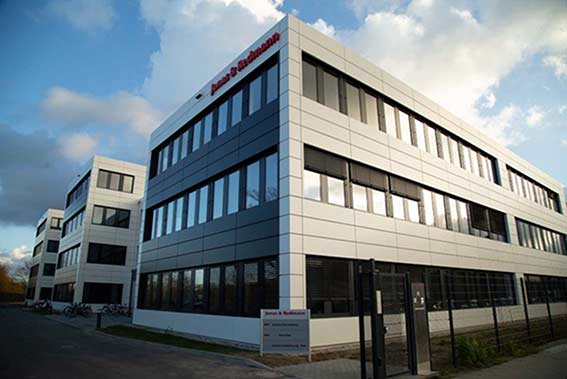Top performance
in battery foil production with
laser technology
Laser cutting of battery foils
Which scan system performs best in battery foil production?
Efficient battery production is core to the future viability of e-mobility. The reason being that faster and more precise manufacturing leads to enormous cost savings in production. Modern laser technology using beam deflection units is again proving to be the best solution for efficient production, especially for cutting foil rolls in battery production.
THE LITHIUM-ION BATTERY IS A COMPLEX CREATION
There are currently three cell formats used in the production of lithium-ion batteries: pouch, cylindrical and prismatic cells.
Regardless of the cell type, which offers both advantages and disadvantages in terms of safety and design, the smallest unit of each lithium-ion cell consists of two electrodes - a coated foil for the anode (copper) and a cathode (aluminium), a microporous separator made of plastic that separates the electrodes from each other, and the ion-conductive electrolyte in-between.
Working principle of a lithium-ion battery cell

Product solution for battery foil cutting
RAYLASE offers a laser beam deflection unit with a wide range of configuration options ideally suited for cutting battery foils -the RAYLASE AXIALSCAN II-50. And more innovative products are in the pipeline.

ELECTRODE FOILS CUT IN CONTOUR WITH THE LASER

In electrode manufacture, carrier foils made of aluminium and copper are coated with electrode material on large so-called mother coils and, after drying and rolling, separated into baby coils. For pouch cells, these are already divided into areas that will later roughly correspond to their cell size, while the coated rolls for cylindrical and prismatic cells have a continuous coating.
The baby coils of coated aluminium and coated copper must next be separated to the desired formats of the cells. In the process, it is not only the coated areas that are trimmed with high precision using the laser beam deflection. Punching
may still be the norm at present, but modern laser systems also offer clear advantages here. For example, the deflection unit allows for both a very straight cut to be made on the coating and the corresponding current conductor flags to be
generated quickly and precisely using contour cutting.
THIS CALLS FOR THE HIGHEST PRECISION AND SPEED
To increase productivity in this process step, both battery foil cutting and the generation of foil stacks for pouch cells are usually carried out with the baby coil running. For cylindrical and prismatic cells these are called foil wraps. This is a highly complex process that requires the highest precision at the greatest possible speed. A task in which modern laser cutting systems can demonstrate their array of advantages and how crucial they have become for the production line.
WEAR-FREE, PRECISE POSITIONING AT UNSURPASSED SPEED
With the appropriate software, laser deflection units can precisely determine belt speed and perform the cut with positional accuracy at outstanding speed. In contrast to conventional punching tools, the laser is completely wear-free. And is cheaper in the long run as it does not need to be replaced or maintained.
LASER BEAM DEFLECTION UNIT
Which particular system configurations of the deflection unit are suitable for which job is determined by the individual process requirements, the materials used and their thickness. In addition, the size of the process field to be processed with a deflection unit plays a significant role in achieving the highest possible productivity. It is also possible to combine several deflection units side by side, overlapping the process fields. The larger the process fields, the higher the demands for the smallest possible spot size, and the higher the speed at which the process is driven.

RAYLASE AXIALSCAN II-50
The AXIALSCAN II -50 with its mirrors for a 50mm beam size can generate an incredibly small laser spot diameter even in large process fields. This serves to ensure a clean and straight cut edge of the electrode foil without scuffing. The particularly light but rigid deflection mirrors also enable high dynamics to execute even 90° changes in direction precisely and without rounding when cutting the current conductor flags (tabs).
The deflection unit is supported by RAYLASE SP-ICE-3 control electronics and the new RAYGUIDE software. These allow a variety of real-time capable functionalities especially for the requirements of e-mobility. “For example, the laser software RAYGUIDE offers an ideal customer interface to the control electronics and can provide an intuitive and highly functional process configuration interface if required. It clearly visualises the processes to be executed and records their execution with
positional accuracy and a time stamp. The control electronics are also able to precisely determine the conveyor belt speed, detected by so-called encoders, even during speed ramps, and to perform the cut with positional accuracy. This function is referred to as “MOTF - marking on the fly“ and allows cutting while the mother or baby coil is running.
RAYLASE und Jonas & Redmann

RAYLASE collaborates closely on laser cutting with several machine builders in the automotive industry. One of them is Berlin-based special machine builder Jonas & Redmann. Axel Albrecht, General Manager for Laser Technology at Jonas & Redmann and an expert in the field sees the advantages this way: ”From cell production to the assembled, ready-to-install battery pack, there is an enormous number of individual production steps, each of which influences overall productivity and output of manufactured units. Laser technology has become
crucial to the process because we can use it, among other things, to minimize maintenance on the machines and keep our customers‘ manpower to a minimum. With the help of pre-focusing deflection units from RAYLASE, we can also achieve a very high-quality laser cut on the electrode foils to be separated
while the foil roll is running.“
Foil cutting is the perfect job for laser beam deflection units. They solve this task with flying colours: faster and more accurately than would ever be possible with conventional punching processes.
